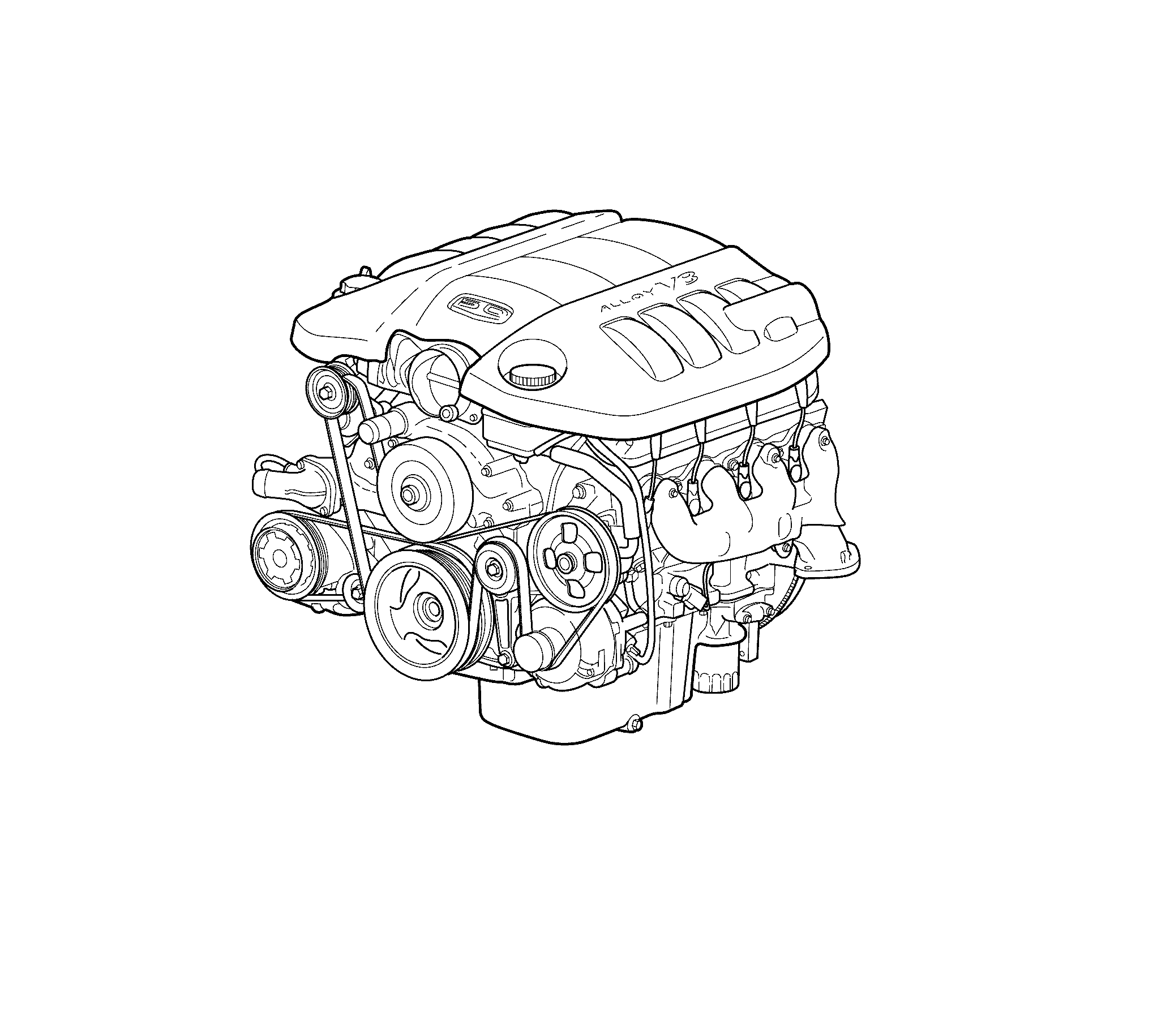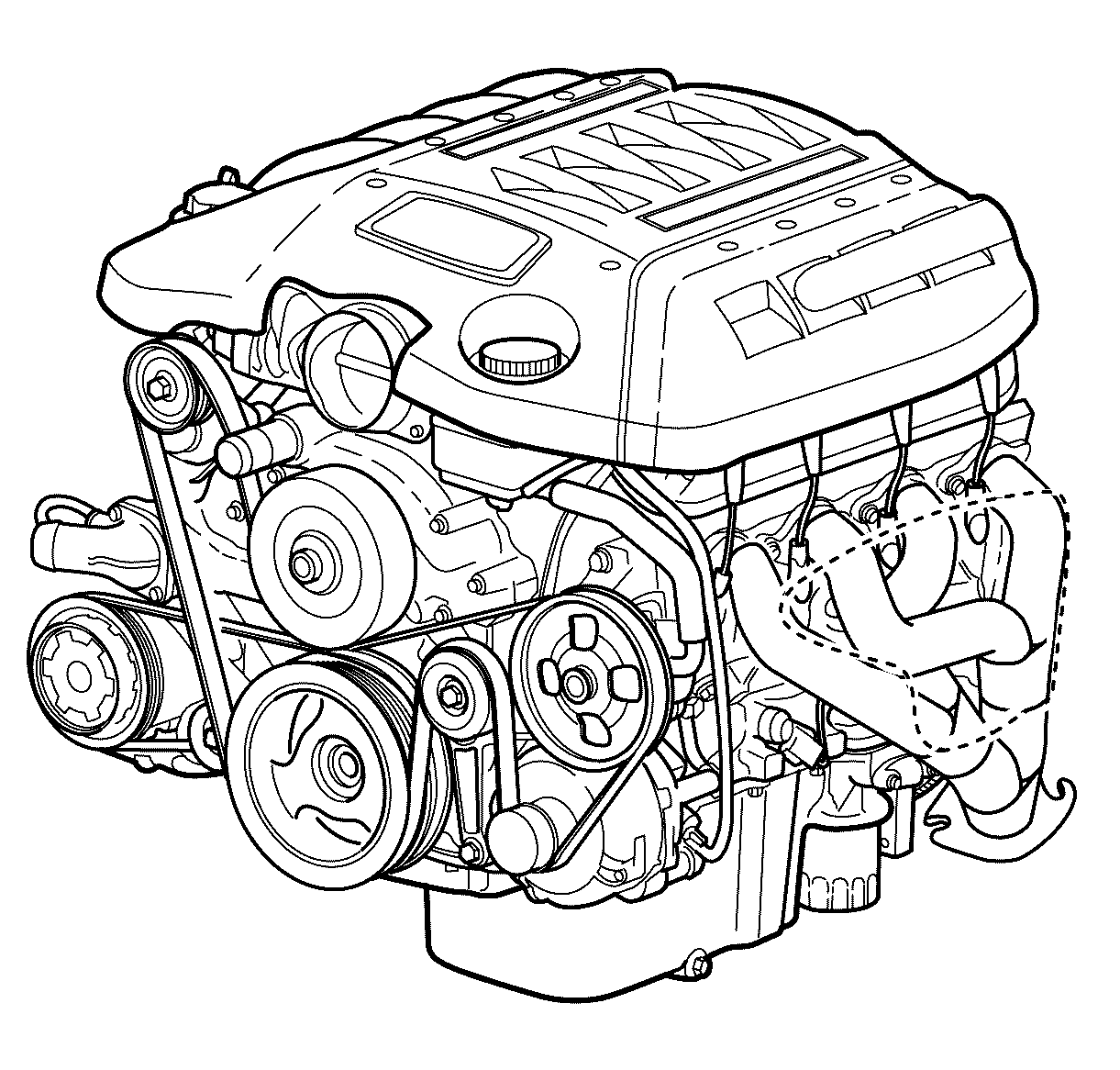Engine Component Description Except HSV Maloo
The 6.0 Litre V8 Engine

Camshaft and Drive System
A billet steel 1-piece camshaft is supported by 5 bearings pressed into the engine block. The camshaft timing sprocket is mounted to the front of the camshaft and is driven by the crankshaft sprocket through the camshaft timing chain. The camshaft position (CMP) sensor lobes are incorporated into the front face of the camshaft sprocket with the CMP sensor mounted in the engine front cover. A timing chain tensioner is mounted to the front of the engine block above the crankshaft sprocket. The externally splined crankshaft sprocket is positioned to the crankshaft by a key and key way. The crankshaft sprocket external splines drive the oil pump drive gear. A retaining plate mounted to the front of the engine block maintains camshaft location.
Crankshaft
The crankshaft is cast nodular iron. The crankshaft is supported by 5 crankshaft bearings. The bearings are retained by crankshaft bearing caps which are machined with the engine block for correct alignment and clearance. The crankshaft journals are undercut and rolled. The centre main journal is the thrust journal. A crankshaft position (CKP) reluctor ring is press fit mounted at the rear of the crankshaft. The reluctor ring is not serviceable separately.
Cylinder Heads
The cylinder heads are cast aluminium and have pressed in place powdered metal valve guides and valve seats. Passages for the engine coolant air bleed system are at the front of each cylinder head. The valve rocker arm covers are retained to the cylinder heads by 4 centre mounted rocker arm cover bolts.
Engine Block
The engine block is a cam-in-block deep skirt 90 degree V configuration with 5 crankshaft bearing caps. The engine block is cast aluminium. The 5 crankshaft bearing caps each have 4 vertical M10 and 2 horizontal M8 mounting bolts. The camshaft is supported by 5 camshaft bearings pressed into the block.
Exhaust Manifolds
The exhaust manifolds are a 1-piece cast iron design. The exhaust manifolds direct exhaust gasses from the combustion chambers to the exhaust system. Each manifold also has an externally mounted heat shield that is retained by bolts.
Intake Manifold
The intake manifold is a 1-piece composite design that incorporates brass threaded inserts for mounting the fuel rail, throttle body, and wire harness studs. Each side of the intake manifold is sealed to the cylinder head by a non-reusable push-in-place silicone sealing gasket. The electronically actuated throttle body bolts to the front of the intake manifold. The throttle body is sealed by a 1-piece push-in-place silicone gasket. The fuel rail assembly, with 8 separate fuel injectors, is retained to the intake by 4 bolts. The injectors are seated into their individual manifold bores with O-ring seals to provide sealing. A fuel rail stop bracket is retained to the rear left of the intake manifold by mounting bolts. The manifold absolute pressure (MAP) sensor is installed and retained to the top front of the intake manifold and sealed by an O-ring seal. The evaporative emission (EVAP) canister purge solenoid valve is mounted to the front of the right cylinder head. There are no coolant passages within the intake manifold.
Oil Pan
The structural rear-sump oil pan is cast aluminium. Incorporated into the design is the oil filter mounting boss, drain plug opening, baffle, oil filter bypass valve, and oil level indicator tube opening. The oil pressure relief valve is also internal to the oil filter. Alignment of the structural oil pan to the rear of the engine block and transmission housing is critical.
Piston and Connecting Rod Assembly
The pistons are cast aluminium. The pistons use 2 compression rings and 1 oil control ring assembly. The piston is a low friction, lightweight design with a flat or recessed top and barrel shaped skirt. The piston pins are chromium steel and are a full-floating design. The connecting rods are powdered metal. The connecting rods are fractured at the connecting rod journal and then machined for the correct clearance. All applications use a piston with a graphite coated skirt. The piston and pin are to be serviced as an assembly.
Valve Rocker Arm Cover Assemblies
The valve rocker arm covers are cast aluminium and use a pre-moulded silicon gasket for sealing. Mounted to each rocker cover are the coil and bracket assemblies. Incorporated into the right cover is the oil fill tube and the positive crankcase ventilation (PCV) fresh air passage.
Valve Train
Motion is transmitted from the camshaft through the hydraulic roller valve lifters and tubular pushrods to the roller type rocker arms. The nylon valve lifter guides position and retain the valve lifters. The valve rocker arms for each bank of cylinders are mounted on pedestals or pivot supports. Each rocker arm is retained on the pivot support and cylinder head by a bolt. Valve lash is net build.
Engine Component Description HSV Maloo
The 6.0 Litre V8 Engine

Camshaft and Drive System
A billet steel 1-piece camshaft is supported by 5 bearings pressed into the engine block. The camshaft timing sprocket is mounted to the front of the camshaft and is driven by the crankshaft sprocket through the camshaft timing chain. The camshaft position (CMP) sensor lobes are incorporated into the front face of the camshaft sprocket with the CMP sensor mounted in the engine front cover. A timing chain tensioner is mounted to the front of the engine block above the crankshaft sprocket. The externally splined crankshaft sprocket is positioned to the crankshaft by a key and key way. The crankshaft sprocket external splines drive the oil pump drive gear. A retaining plate mounted to the front of the engine block maintains camshaft location.
Crankshaft
The crankshaft is cast nodular iron. The crankshaft is supported by 5 crankshaft bearings. The bearings are retained by crankshaft bearing caps which are machined with the engine block for correct alignment and clearance. The crankshaft journals are undercut and rolled. The centre main journal is the thrust journal. A crankshaft position (CKP) reluctor ring is press fit mounted at the rear of the crankshaft. The reluctor ring is not serviceable separately.
Cylinder Heads
The cylinder heads are cast aluminium and have pressed in place powdered metal valve guides and valve seats. Passages for the engine coolant air bleed system are at the front of each cylinder head. The valve rocker arm covers are retained to the cylinder heads by 4 centre mounted rocker arm cover bolts.
Engine Block
The engine block is a cam-in-block deep skirt 90 degree V configuration with 5 crankshaft bearing caps. The engine block is cast aluminium. The 5 crankshaft bearing caps each have 4 vertical M10 and 2 horizontal M8 mounting bolts. The camshaft is supported by 5 camshaft bearings pressed into the block.
Exhaust Manifolds
The exhaust manifolds are a 10-piece tubular steel design. The exhaust manifolds direct exhaust gasses from the combustion chambers to the exhaust system. Each manifold also has an externally mounted heat shield that is retained by bolts.
Intake Manifold
The intake manifold is a 1-piece composite design that incorporates brass threaded inserts for mounting the fuel rail, throttle body, and wire harness studs. Each side of the intake manifold is sealed to the cylinder head by a non-reusable push-in-place silicone sealing gasket. The electronically actuated throttle body bolts to the front of the intake manifold. The throttle body is sealed by a 1-piece push-in-place silicone gasket. The fuel rail assembly, with 8 separate fuel injectors, is retained to the intake by 4 bolts. The injectors are seated into their individual manifold bores with O-ring seals to provide sealing. A fuel rail stop bracket is retained to the rear left of the intake manifold by mounting bolts. The manifold absolute pressure (MAP) sensor is installed and retained to the top front of the intake manifold and sealed by an O-ring seal. The evaporative emission (EVAP) canister purge solenoid valve is mounted to the front of the right cylinder head. There are no coolant passages within the intake manifold.
Oil Pan
The structural rear-sump oil pan is cast aluminium. Incorporated into the design is the oil filter mounting boss, drain plug opening, baffle, oil filter bypass valve, and oil level indicator tube opening. The oil pressure relief valve is also internal to the oil filter. Alignment of the structural oil pan to the rear of the engine block and transmission housing is critical.
Piston and Connecting Rod Assembly
The pistons are cast aluminium. The pistons use 2 compression rings and 1 oil control ring assembly. The piston is a low friction, lightweight design with a flat or recessed top and barrel shaped skirt. The piston pins are chromium steel and are a full-floating design. The connecting rods are powdered metal. The connecting rods are fractured at the connecting rod journal and then machined for the correct clearance. All applications use a piston with a graphite coated skirt. The piston and pin are to be serviced as an assembly.
Valve Rocker Arm Cover Assemblies
The valve rocker arm covers are cast aluminium and use a pre-moulded silicon gasket for sealing. Mounted to each rocker cover are the coil and bracket assemblies. Incorporated into the right cover is the oil fill tube and the positive crankcase ventilation (PCV) fresh air passage.
Valve Train
Motion is transmitted from the camshaft through the hydraulic roller valve lifters and tubular pushrods to the roller type rocker arms. The nylon valve lifter guides position and retain the valve lifters. The valve rocker arms for each bank of cylinders are mounted on pedestals or pivot supports. Each rocker arm is retained on the pivot support and cylinder head by a bolt. Valve lash is net build.
